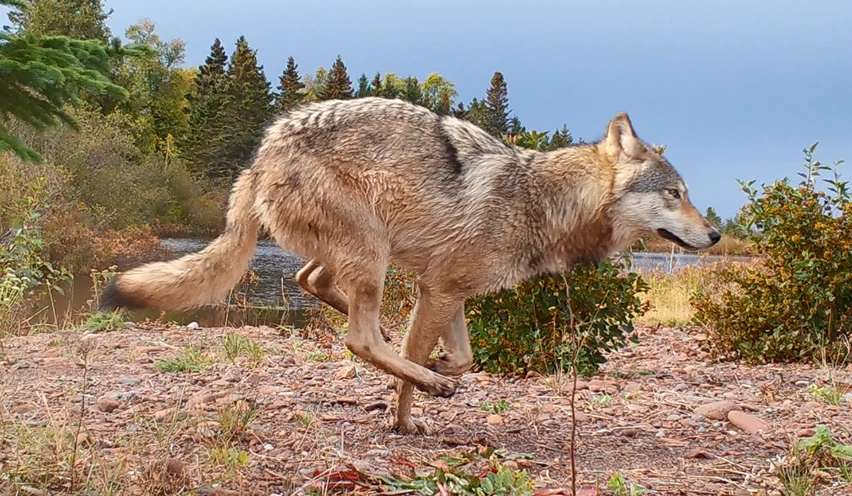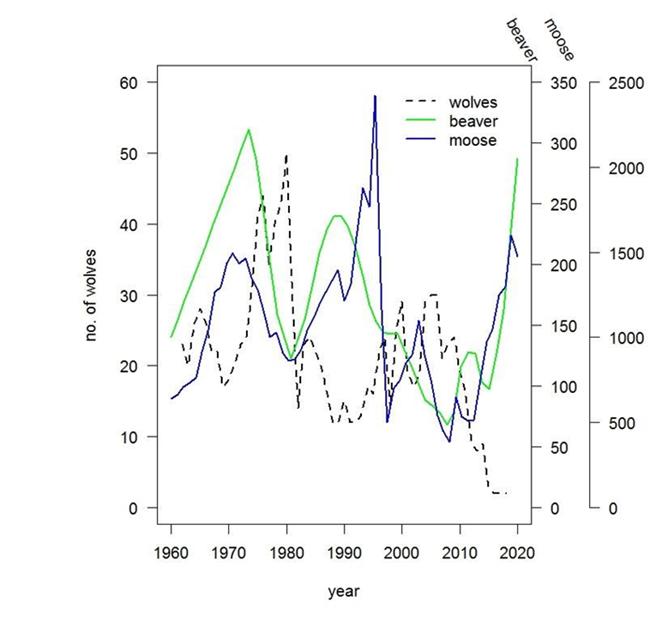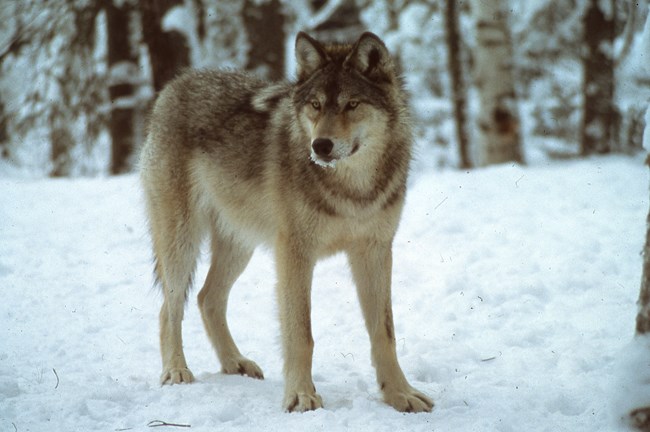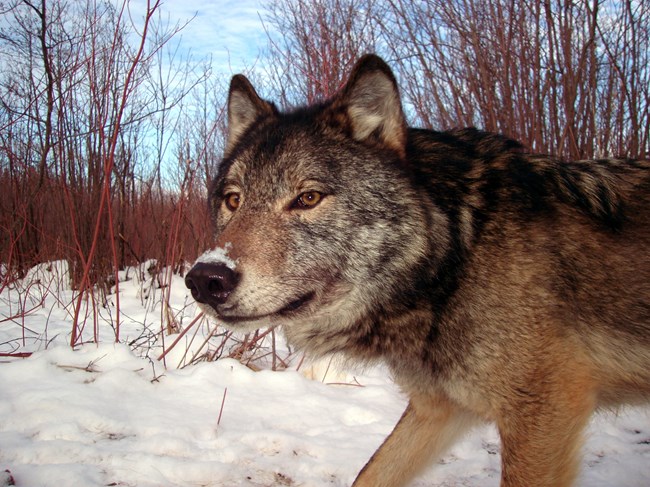Last updated: July 6, 2025
Article
Why Relocate Wolves to Isle Royale?

Photo Courtesy of National Parks of Lake Superior Foundation and Drew Rush.

NPS/SUNY-ESF/MTU
Hands Off or Help Out?
Wolves have played an important role in predator-prey relationships on Isle Royale. Hearing a wolf howl or seeing a track along a muddy trail have long been a part of the island wilderness experience. These wild sounds and sightings have been slight since the wolf population decline. The National Park Service began to ask the question, should humans help out or step back and let nature take its course?
Look at the graph to the right. The number of wolves, moose, and beaver has fluctuated over time. In 2012, the wolf population decline raised concerns with researchers. In 2015, the National Park Service began to determine why and how wolves should be relocated to the park in hopes to preserve and protect the isolated wolf population.
Reasons for Relocating
Wolves have played an important role as the single apex predator on the main island and surrounding islets of Isle Royale National Park since the late 1940s. Wolves impact abundance of prey on the island by hunting moose, beaver, and snowshoe hare. These complex predator-prey relationships have been researched at Isle Royale National Park for over 60 years and continue to be studied today. Wolves indirectly impact the amount and distribution of vegetation on the island since they primarily prey on herbivores like moose and beaver. What would the island ecosystem look like without wolves as an apex predator?
The legal protection status of the gray wolf has changed several times in the United States at the federal and state level. Gray wolves historically were found across North America and have been residents of Isle Royale National Park since the late 1940s. Gray wolves in the lower 48 states were first listed as “endangered” under the Endangered Species Act in 1974.
The Isle Royale wolf relocations began in Fall 2018 when gray wolves in the Great Lakes region were still protected by the U.S. Fish and Wildlife Service (USFWS) reinstatement of gray wolves to the Endangered Species List.
Learn about the current status and history of legal protection for gray wolves.
The populations of wolf, moose, and beaver have fluctuated over time. The population peaked at 50 wolves in 1980, stabilized briefly at about 25 wolves, and declined to just two wolves in 2018. This rapid decline and lack of new wolves immigrating to the island raised concern with scientists. Many believed that the persistence of wolves was doubtful unless new wolves were introduced to the island or came on their own.
Why Did the Wolf Population Decline?

NPS
The Isle Royale wolf population has changed over time since their first immigration in the late 1940s. The wolf population declined drastically in 1980 and again in 2012 due to a combination of events including disease, climate change, random events, and loss of genetic diversity.
Canine Parvovirus (CPV2)
A global CPV2 outbreak in 1978 was detrimental to wolf populations across the world. It was only a matter of time before CPV2 made its way into the Isle Royale wolf population. It is not certain how CPV2 made it to the island, but in 1980 the wolf population declined and it was later found that CPV2 was present in the wolf population.
CPV2 and Susceptibility of Pups
Wolf pups are more susceptible to CPV2 since they are not born immune. Pups are especially susceptible once they are weaned from their mothers. It is possible that Isle Royale wolf pups were impacted by CPV2 during the early 1980s.
Lyme Disease
Lyme Disease has been found in Isle Royale wolf populations but has not been found to directly impact mortality or population dynamics.
Wolves originally migrated to the island by walking across an ice bridge that formed between the island and the mainland across Lake Superior. Wolves have migrated to and from the island via ice bridge since their island arrival. This icy connection allowed for gene flow between mainland and island wolves. Wolves immigrating to the island on their own have been impacted by the influence climate change has on weather events and patterns. Ice bridges still form in cold winters, but the pattern and frequency of them occurring has changed over time. This change impacts the journey of wolves to and from Isle Royale.
Wolves Fall into Mine
In May of 2012 animal carcasses were spotted by a park biologist floating in water of a deep 19th century mine shaft near Todd Harbor on Isle Royale. The animal remains were collected and a harrowing story unfolded. It was revealed that during the past winter, before winter researchers arrived on the island for winter study, three wolves fell into the water filled mine shaft. Remains of two older wolves (male and female) and one younger female wolf were found in the mine. The incident likely occurred sometime between fall 2011 and winter 2012. How did three wolves fall together into the mining pit? There is no way to be sure, but it is likely that snow and ice played a part in this accident.
This event occurred at a critical time in the history of Isle Royale wolves. The loss of a young female, when there was already a shortage of females present in the population at the time, appeared to cause the largest extinction risk for the population.
M93
Male (M) wolf 93 migrated from nearby mainland Ontario, Canada in 1997, probably across an ice bridge present that year. Wolf M93 was behaviorally dominant over local wolves. M93’s pack, first mate, and descendants quickly dominated the genetic bloodline of the population. By 2008, more than 50% of the wolf population were descendants of M93. From 2005 on, all the ancestry of wolves on Isle Royale came from three wolves, immigrant M93, and two females, F99 (M93’s first mate) and F67, another female wolf.
Last Two Wolves
In summer of 2018, the wolf population hit a low of two island-born wolves. These wolves were severely inbred, and were father and daughter as well as half-siblings. Things soon changed in fall of 2018 when wolves were relocated to Isle Royale National Park and genetic rescue began.
News Coverage of Isle Royale Wolves' Mine Shaft Accident

Photo Courtesy of Rolf O. Peterson, Michigan Technological University.
What Did the Park Do?
As the wolf population continued to decline at Isle Royale, extirpation seemed likely. In 2015, the National Park Service (NPS) began to officially determine how to manage wolves and assessed four management alternatives documented in an environmental analysis. The chosen alternative (B) consisted of one or more introductions of wolves to Isle Royale National Park within a five year period. The aim of this alternative was to introduce enough wolves to restore the wolf population and sustain island predator-prey relationships.
The Draft Environmental Impact Statement (EIS) was initially prepared for the National Park Service (NPS) to determine how to best manage the population of gray wolves on Isle Royale. The purpose of the draft EIS was to determine whether and how to bring wolves to Isle Royale to refill the role as the apex predator within a dynamic island ecosystem.
The NPS established a panel of scientists to consider aspects of translocating wolves to Isle Royale. Experts' feedback was implemented in the final Environmental Impact Statement (EIS).
Public Scoping
The National Park Service invited the public to participate in information open houses and webinars to discuss the possibility of relocating wolves to Isle Royale National Park, as proposed in the draft EIS. Public comments on the draft EIS were accepted and used to create the final EIS. Four action alternatives were formulated after experts and the public were consulted about the possible project. These action alternatives are found in the final EIS and are compared below.
Public Scoping Newsletters and Correspondence
The Final Environmental Impact Statement evaluates whether and how to bring wolves to Isle Royale. The National Park Service preferred alternative was Alternative B, which calls for the introduction of 20 to 30 wolves over a three-year period. The goal of this alternative was to provide an introduction of wolves that had the potential to become a self-sustaining population.
The National Park Service released the Record of Decision (ROD) on June 7, 2018. This release signified the completion of the wolf relocation planning effort. The ROD includes the decision, description of the selected alternative (alternative B above), and the environmentally preferable alternative, and discusses the basis for the decision to relocate wolves to Isle Royale National Park.
The National Park Service and partners began to implement the Record of Decision to achieve restoration of wolves to Isle Royale. This included introduction of genetically diverse wolves from a broad geographic area within the Great Lakes region. The panel of scientists that helped with the EIS were consulted for the relocation of wolves. The wolf relocation included radio or GPS collar tracking from ground and air, scat sample collections, and visual observations.
Actions Considered
These action alternatives were created from internal and public scoping, agency input, and past and ongoing planning efforts. Alternatives B, C, and D include the capture and relocation of wolves from the Great Lakes Region to Isle Royale National Park.
Pro: Least impact to wilderness.
Cons:
Island Ecosystem: broad changes to forest composition and structure could be further influenced by climate change and increased plant consumption.
Moose: Without wolves, moose population would likely increase and could deplete their food source. A large-scale starvation event could possibly occur.
Wolves: Original population would likely be extirpated from island. Presence of wolves on the island would depend on natural immigration, which is unlikely due to reduction of ice bridge formation because of global climate change. Wolf reproduction would be unlikely because of low genetic diversity and inbreeding.
Under alternative B, the park would introduce wolves over a three year time period. After the third year, if an unforeseen event occurred (disease or mass mortality), wolves may be supplemented for an additional two years. No wolves would be introduced after five years from the initial introduction.
Pros:
Island Ecosystem: Restore an apex predator and the process of predation to the island. Retain forest components.
Wilderness: Restore an ecological function (predation) on the island and benefit the natural quality.
Moose: Reintroducing predation to the ecosystem would reduce the fluctuations of the moose population.
Wolves: Island wolf abundance and distribution would increase. Genetic variation would increase with the aim to delay any potential future inbreeding problems
Cons:
Wilderness: The wilderness character of the island would be impacted. This alternative includes the use of radio collars and mechanized transport that impact the untrammeled and undeveloped qualities of wilderness.
Pros:
Island Ecosystem: Restore an apex predator and the process of predation to the island. Retain forest components.
Wilderness: Restore an ecological function (predation) on the island and benefit the natural quality.
Moose: Reintroducing predation to the ecosystem would reduce the fluctuations of the moose population. A smaller number of wolves would be introduced, allowing some predation pressure. Future introductions of wolves would be allowed to manage the moose population as needed.
Wolves: Relocating a lower number of wolves would best reflect a natural migration event. This would initially result in a lower genetic diversity in the short term. The NPS would have the ability to relocate wolves and increase diversity as needed.
Cons:
Wilderness: The wilderness character of the island would be impacted. This alternative includes the use of radio collars and mechanized transport that impact the untrammeled and undeveloped qualities of wilderness. Additional impacts to wilderness could occur depending on the number of introduction events.
Pros: All pros are depending on if future action occurs. Pros would be similar to alternatives B and C.
Wilderness: If action did not occur, nature would be allowed to take its course without human influence.
Cons: All cons depend on if future action occurs.
Wolves: A delayed response could lead to the the original wolf population being extirpated and new wolf relocations would possibly establish a new, genetically different, population.
Moose: A delayed response could lead to the moose population continuing to increase until a possible moose population collapse due to starvation or winter moose ticks causing illness.
Wilderness: If action occucred, the wilderness character of the island would be impacted. This alternative includes the use of radio collars and mechanized transport that impact the untrammeled and undeveloped qualities of wilderness. Additional impacts to wilderness could occur depending on the number of introduction events.
